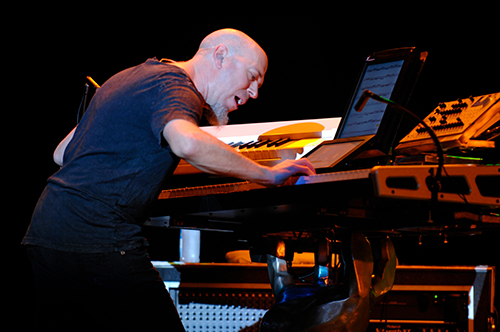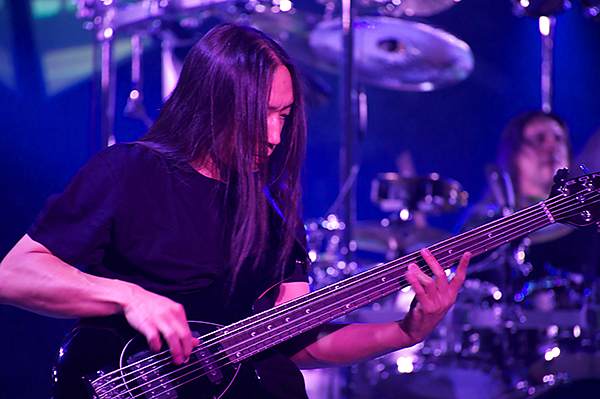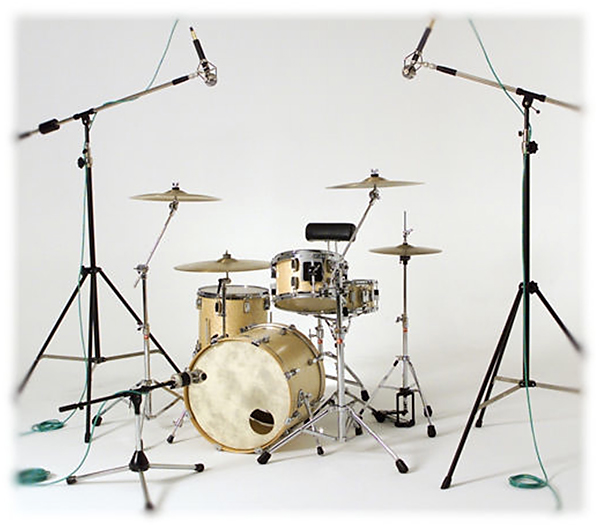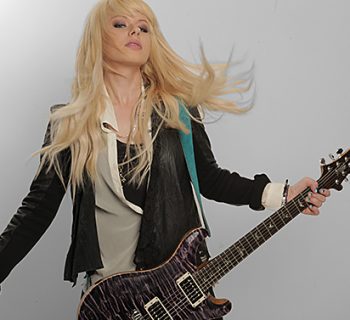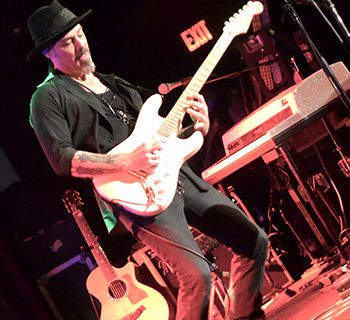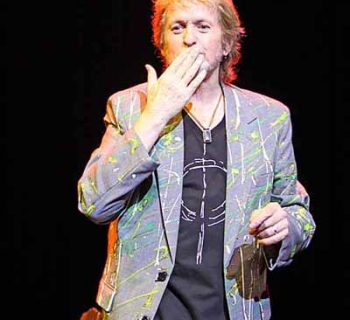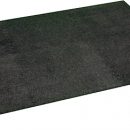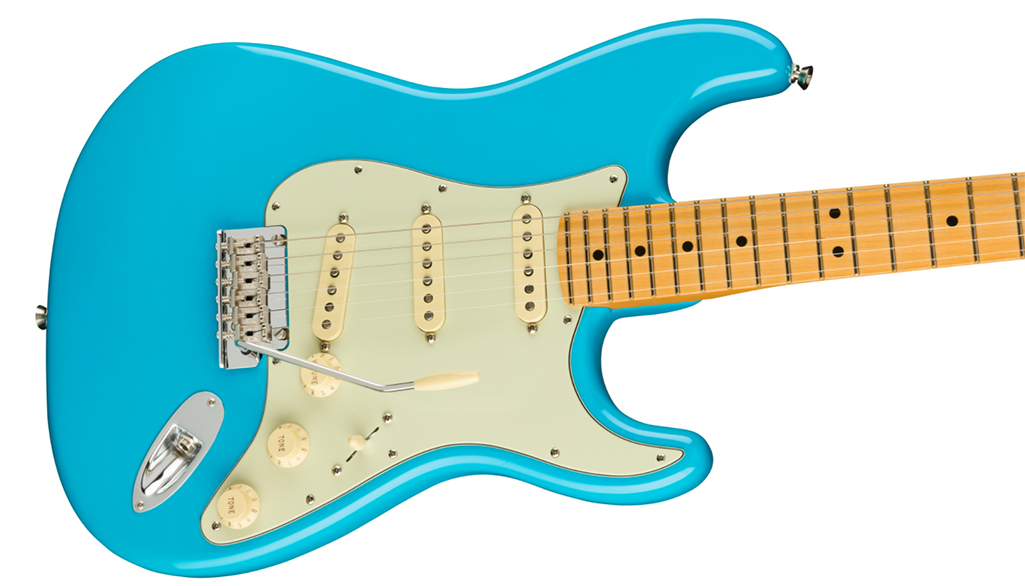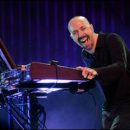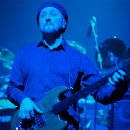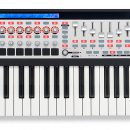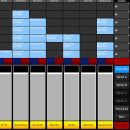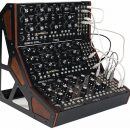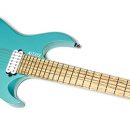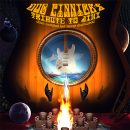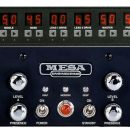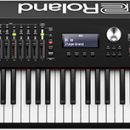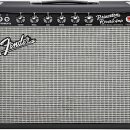How do we introduce the man we seem to interview with more regularity than any other major league keyboard player? Yes, we sat down once again with today’s leading keyboard virtuoso, this time to talk about the making of Dream Theater’s latest, self-titled album, as well as a variety of other projects that Jordan has been working on.
If you haven’t listened to Dream Theater, the new album is filled with a fantastic collection of songs that really draws upon the band’s classic influences across the board, from classical music to metal to prog rock. To some listeners, it’s a return to form of sorts, harkening back to the earliest Dream Theater albums. To the band’s most recent fans, it’s a bit more song focused and direct in its approach than the last few records, and the closing track delivers one of the finest, epic progressive metal songs the band has ever recorded. We could go on and on, but instead we’ll just let Jordan tell you all about it.
We went for the big orchestral thing, and on this album we used… real string players.
MPc: So… Dream Theater, self-titled album. 12th studio release, I believe.
JR: Yeah, keeps coming.
MPc: Tell me about it. Give me the background, in your own words.
JR: Well, we were excited to get into the studio and make an album, especially with Mike Mangini coming in, for the first time to join us. [Editor’s Note: When Mangini joined Dream Theater, the songs for A Dramatic Turn of Events had already been written.] There’s always a lot of built-up excitement as we move towards the studio, think about what we want to create, where it’s going to be created, and all the different factors that go into getting yourself in the right head-space and physical place to make an album.
So when we got in there, we extend a little bit of patience before we start, like, jamming like crazy people. We generally sit down and get out some large pieces of paper and start to write down the ideas for the album, concepts, what we’re trying to achieve… The first couple days of a Dream Theater recording session are almost like going to school, because we tend to be very organized. So that’s what we did for this one.
MPc: How much is written, song wise, before you get together? Is it a case where you write a bunch of things and John writes a bunch of things?
JR: Well, when we’re on the road we do all these sound checks, and sometimes at the sound checks we can try out an idea—not that many things, but there’s a handful of cool things that we stop and record and then go back to, and include in the album. So it’s definitely little parts that we’re able to say, “Hey, remember that day in Frankfurt, Germany or something where we had that cool idea?” So there are those things. But a lot of things are done right in the studio, a lot of the music is written right there. So that’s kind of the way things come up.
Most of the music is written by John Petrucci and myself, and we kind of feed off each other, a lot.
MPc: Do you guys ever get together locally and do jam sessions for the writing?
JR: Just the two of us? No, we haven't done that. When we record we have our studio time booked. It's like kind of going to work, and we sit there and just kind of do what we have to do… and if we need to spend time by ourselves, like without the band—on the last album there were times when we just did that too. A good example is the song, "False Awakening," where it was just the two of us basically and we just sat in the room and kind of put that piece together.
MPc: Let's talk about the album bookends, "False Awakening Suite" and "Illumination Theory," which both have some pretty big orchestral things going on.
JR: Yeah. Well, the “False Awakening Suite,” the whole purpose of that suite was that we wanted to write something that was the equivalent to the music that we play before we hit the stage. John had this idea that he thought maybe we could write the piece ourselves, something like a Psycho opening, or like the Hans Zimmer thing we used last time, from Inception. And when he said that to me I was like, “Yeah that’s a great idea.” I was totally into it, I can do that type of thing.
So we sat down and decided, okay, we’re going to create this opening piece ourselves, and at some point we said this has to be on the album, because this is a really cool way to start the album, and in addition it’ll be the opening number on tour. And “Illumination”… yeah, we went for the big orchestral thing, and on this album we used, in those two songs, we used real string players as well. We had nine guys, nine string players, come into the studio and then a young protégé of mine, Eren Ba?bu?, I gave him what I did on the synthesizer and he fleshed it out for the real players and came in and conducted them and it added a nice element, certainly, to this bit.
But it was very orchestral, even coming from a synthesizer point of view. So actually “False Awakening” was huge and then we made it even bigger by adding the real strings. And the middle section of “Illumination,” which breaks down into a very, kind of, beautiful string melody, is pretty much all the string players, just by themselves. It sounds really, really pretty.
MPc: I loved that section. "Illumination Theory" in general is just a fantastic song, but when it gets to the orchestral section in the middle, I thought, "Oh, this is just awesome!"
JR: Yeah, yeah it is nice. That part, we were in the studio, and John said to me, "Play them the most beautiful, saddest kind of melody you can come up with." And I just improvised most of that. When he said that, I just was in the spirit of it and I played it and everybody went, "Wow, that's really great, just like that, great!" So I wrote it down and then that was it. You know, sometimes these things flow.
MPc: What do you call that piece? Is it part of a musical trilogy you're working on in D minor, the saddest of keys? [laughs]
JR: Funny, yep. [laughs] [Editor's Note: As a MusicPlayers.com reader we expect you to know the joke reference above.]
MPc: Songs like "The Looking Glass" and "Surrender to Reason" both paid a pretty obvious homage to Rush. Were you consciously looking to throw in those tributes?
JR: Well you can't seem to shake out the Rush elements from Dream Theater, you know? It's just like—honestly, you know, I love Rush. I think they're great. But the spirit of Rush doesn't really come from me; that's not my thing. But Dream Theater is kind of coming from a similar school of thought and spirit as Rush in a lot of ways, so it kind of makes sense that there's a little bit of homage, if you will, to that band.
MPc: Now tell me about "Enigma Machine." It's been a while since we heard a real hardcore instrumental.
JR: Yeah, we wanted to create an instrumental, it’s been a while. And we wanted to come up with an instrumental that was a little bit more to the point, a little shorter than previous instrumentals. But also, that really had [something] kind of catchy, almost like a the theme. We wanted it to be like a, I don’t know, like a television theme or something, that really had its own kind of hook to it. So I kind of felt like I got a bit of an assignment, you know, to come up with a riff that was a really catchy, cool riff.
I woke up in the middle of the night one night, and basically had that main riff in my head and I jotted it down—actually I sang it into my iPhone at the time. And in the morning, when I woke up I went, “Wow. I wonder if that was a cool idea?” [Laughs] So I listened to it again, “Dun, nun, dun, danana” [hums the riff] I think when I first wrote it, it was more of a dotted time thing, more jazzy [Jordan serenades me again…]. So I played it for John and he was like, “Yes! That’s great!” So we took it and the song was born.
MPc: It's funny that you mention the jazz vibe because I immediately noticed the jazz chord voiceings you were playing the first section of the song on keyboards, sort of Chick Corea-like.
JR: Interesting…
MPc: And then of course it goes into the keyboard solo that, you know, makes mere mortal keyboard players like me feel that we don't actually know how to play keyboards.
JR: There you go.
MPc: Not you. The listener, I mean. [laughs]
JR: Okay, that's better. I'm glad you clarified that [laughs].
MPc: What can you tell me about "The Bigger Picture?"
JR: That was actually one of my favorite songs for a while. I like that song because it's very open, it's cinematic sounding... it's just got kind of a good feeling, sort of epic vibe to it.
"I'm trying to understand the perspective of people who don't like that sound."
MPc: Something that you mentioned when you were talking about "The Enigma Machine": you were looking to make an instrumental that was a little more to the point. You actually had more songs in general on the new album, that were "to the point." It seemed like a lot of songs came in under the five- or six-minute mark.
JR: Yeah, like six minutes, we wanted to do that. We felt like it's time to make an album on which we kind of take the Dream Theater style and hone it in a little bit. Not to simplify it, you know, but just to get the songs a little bit more dialed in, if you will. I think we achieved that goal.
MPc: Yes. "Behind the Veil" had another orchestral moment on the record.
JR: Right, and that happens at the beginning of the song. That was really fun. We had this idea of doing a French horn thing with orchestra and we liked it, but we were thinking about, listening back to some rough tracks we put down, and thinking that the—we didn’t really want to do another orchestral approach because we had that string element in “Illumination Theory” and everything. So I was trying to think, I really wanted to do a little keyboard-like introduction, so I was thinking, What can I do?
So, that song does start with kind of like a French horn sound, but around it are these more ambient electronic type sounds. And then it goes into another bit, and what I decided to do was I wanted to make it cinematic but I didn’t want to make it orchestral cinematic. So I made it orchestrated but I used… I primarily got a lot of inspiration from the soft-synth called Alchemy, because it’s one of the greatest synthesizers out there today. But also because they have a really, really great sound library. And there’s this one package they have, I think it’s called “Dream Voices,” and I was really inspired by it. So I said you know what? Let me call up this different sound and see what happens. I mean a good synthesizer leads a musician to inspiration. I thought, let me call up some patches and go for it.
So I started to call up some different patches and I’d find one that I’d be really inspired by, and Rich [Chycki] was there with me in the studio—it was just me and Rich, the engineer. And I said “this is a cool sound, okay let’s go for it.” I started to just play that one, lay down a track and then I’d find another sound and go “this is cool.” So I would just kind of, you know, after an hour or two, all of a sudden I was building up this whole orchestration, and that’s how that bit came out. I think it came out really well. It’s again, orchestral in nature but it’s not an orchestral sound. It’s a more cosmic kind of approach.
MPc: One of my favorite songs on Dream Theater has got to be, "Along for the Ride." It's such a great song, with the '70s classic rock vibe to the chorus, the melody, then you come in with this solo that's—
JR: The "Lucky Man" solo?
MPc: Yes.
JR: Right... That some people felt, don't seem to like it, but other people love. It's odd. If you read all the comments—you know, you read down the comments [online] when we released the song, some people say "Oh, that's like a Casio synthesizer, lose that sound." And I'm like, "What? Wait a minute!" I'm trying to understand the perspective of people who don't like that sound, and all I can think of is maybe they're younger, maybe more metal kids who aren't used to synthesizers, and they hear that and it just hits them the wrong way and they don't get it. Like for us, it's a great synthesizer, it's a classic, and also a really great synthesizer sound.
MPc: Funny, I played that song for some people in the studio and they all basically said, "This is amazing."
JR: Yeah, but you do have other people that… I guess when you're Dream Theater and you put yourself out there, there's a lot of people, you hit so many different kinds of people, and nowadays with the Internet everybody's got an opinion and a voice and everybody wants to be heard, and it's interesting to see that people literally come back and say "It sounds like a Casio, lose the sound, ruins the song." And I'm, like, "I thought it was cool." [laughs]
MPc: And here I almost re-bought a Casio CZ-5000, so what's with those people?
JR: Right, right. And Casio is cool, Casio could be good there. Matter of fact, that sound was made on a Casio—I’m kidding! Actually, it wasn’t, but it could have been! I’m sure the CZ-5000 could’ve come up with a nice version of that. [laughs] People don’t understand that Casio synthesizers are actually pretty cool. CZ-101, 5000…
So you like that song, I’m glad. John started writing that song by himself and it was really beautiful. And then he was in the studio, kind of playing away and I looked in and I said hey, what about, we should do something, maybe something like this. And he was like, “Yeah that’s a cool idea,” so…
MPc: Nice. Now, earlier were talking about your use of Alchemy. How much do you rely on soft-synths in the studio versus your physical keyboards?
JR: I use everything in the studio, it’s a big sonic party. I use my [Korg] Kronos a lot, that’s the main keyboard I use. But I’m also surrounded by other keyboards that I use for quickly writing stuff. I use the soft-synths a lot when I’m actually tracking. I do a lot with Omnisphere. The big ones that I go to are Omnisphere, which has been with me for some years now, and is probably on the top of the list of handy places to go to when you need the magic. And then of course the Camel Audio Alchemy is an incredible synthesizer. I have all the different libraries and it’s excellent.
And then I also use—I’m a big proponent of the Synthogy Ivory piano plug-in, because I mean it’s wonderful. And I use Contact, the Native Instruments stuff a lot. What else? I’ve used—one of the things that I really got into for this album is some buddies of mine have this company called Heavyosity that make packages like Evolve and Damage, and a new one called Eon. And their libraries are very different than other peoples. What I discovered with one of them, I think it was the Damage library, they have all these… now I know where all the sounds come from that are in the movies, because they have this one library that’s, like, every note you play on the keyboard is another one of those big impact sounds that shake the whole theater. [laughs] And I was, like, wow, okay. So those fell into place in the right moments, like in “False Awakening” and other places as well.
"I was deep in my world, door closed, world shut out, and it was like that for at least a month."
MPc: It seems like with every new album you're always introducing something new to the keyboard world. You made use of the Continuum, then you introduced software apps, like Morphwiz, or your Tibetan bells on the iPhone. Now we've got the Roli Seaboard that you're involved in. So tell me, have you grown tired with the limitations of the traditional keyboard?
JR: Well, the Roli Seaboard is really a cool, new instrument. It's not even out yet, but it will be soon. And I used it in a couple places on the album, both in "The Veil"—in the introduction to that, and also in the outro bit, it happens after "Illumination."
MPc: What does it let you do?
JR: The interesting thing about the Seaboard is that it’s kind of like the evolution of the piano keyboard as we know it. It’s got kind of an elastic touch to it, it’s the layout of a keyboard, but it’s not like actual keys. And we think of it as having a continuous touch, so your finger goes down on a key and then your finger can actually sink it the key. And the concept is that every key is an individual voice. So you could do things like play a three-note chord, and one of the notes you can press into and maybe bend the pitch while leaving the other ones alone. So it kind of gives you the same expression that you would on an instrument like a guitar or a violin, where every note you play can be expressed, leaned into, change the pitch. And to me, offering a keyboard player that type of ability is amazing. It’s why I wanted to play the Continuum, which does a similar kind of thing, but the continuum is not in the form factor of a keyboard. So that’s the big difference with something like this; there’s been a lot of alternative controllers out there that are really, really cool. The problem is that so often they’re so left of center for people that they don’t have any idea like how to approach them because there’s no background experience that leads them up to that.
But with the Seaboard, it’s kind of like, okay, this is a form of a keyboard. So if you have studied the keyboard, if you know the keyboard, then you can walk up to it and at least begin. It might not become immediately apparent how to play it, but you can do something on it. And some people take to it more easily than other people, you know it depends on where you’re coming from, how open you are. But for me, I’m just excited about it; actually I’ve been working with the company, kind of as an consultant, because it really is a very important product. It’s going to be something that keyboard players will want in their rigs, because it will be able to do things that their other keyboards just cannot do.
And the first thing I did when I started to work with them is I said “You guys gotta’ make this so that anybody can get it, and without any computer or iPad around; they can plug it in and it can make sound and do the magic thing that it does.” Because too often these controllers, you have to be able to interface with computers and you gotta’ be some kind of a rocket scientist, and you know there are musicians who are technical and of course not technical, and those musicians even if they’re somewhat technical, are not up to the level of figuring out this crazy system to be able to get these alternative controllers to talk to the computers. It’s more technical than most musicians want to be. And although I’ve done it kind of out of necessity—that type of set up, I don’t want to do it either. So I said to them you gotta’ really make this something that is more friendly to a musician. So that’s kind of the background of that keyboard.
In addition to that, on this album—I wasn’t able to do this on the last album, because the software wasn’t ready, but I used Geo Synthesizer on this album as well, I played lead, one my leads is on Geo Synthesizer.
MPc: Which lead?
JR: I think it's in "Enigma Machine." Yeah… second one, my second keyboard lead.
MPc: The past year, you've been busy. Besides Dream Theater you've also released a pretty interesting CD with Tony Levin and Marco Minnemann. So tell me about that.
JR: Sure… I'm really excited about it. You know, when I was first exposed to Marco Minnemann playing over some videos, I thought, "man, this guy's amazing."
MPc: Did that start with the Dream Theater drummer auditions?
JR: No, no I kind of discovered Marco’s playing just by looking around and seeing who was out there and discovered this amazing drummer. And, people had been telling me about him for a couple of years. So when the Dream Theater thing came up and we needed a drummer I thought, let’s have this guy Marco Minnemann come in. Started talking to him more and we became kind of friendly; I was excited about having him come down. So of course then he came down to audition and the reality of getting together with him and seeing him play, I was like, this is a no brainer, I’m gonna’ be making music with this guy whether he’s in Dream Theater or not.
You know, we had incredible drummers come to that audition and they all had their own magic. It was… the decision was much more than drums. It had a lot to do with a lot of factors. So with Marco I just felt like this is a guy I want to work with, so we quickly after the audition figured out some ways to work together.
But the way this particular album came up is that Tony and Marco started to work together on it, months before they even got me involved, and of course Tony [Levin] I have experience working together through the Liquid Tension Experiment, and Tony and I are very compatible musically, both having a classical background and understanding musical notation and kind of coming from that point of view. And also, both of us having good musical ears and relating to different styles, that’s a very natural fit. So when I got an email from the producer, this very nice guy named Scott [Shore], in New Zealand and he told me about this project that they were looking for a third guy to kind of complete what they had been working on, I was really interested, ‘cause “Wow, I get to work with Marco. I get to work with Tony,” you know, tell me what’s going on and maybe we can work something out.
So I was really interested in that. I thought it was very, very cool. And Scott the producer said that—I was talking to him and it sounded like it was going to be kind of a quick, easy project for me. He said it’s all just… go into the studio, do some improvisation, send ‘em to me, I’ll move them [session files] around; just get inspired, play whatever you want on it. Okay, so that’s a ten day, two week thing; still kind of finishing up my Dream Theater work. So I thought, two weeks, that’s a reasonable amount of time to spend on a project, that’s cool.
So he started to send me the stuff, and he sent me more stuff, and more stuff, and all of a sudden there were like fourteen or fifteen songs. And I’m like, wait a minute, and I listened to them, and some of the stuff were, like, Marco compositions, that were rhythmically and harmonically really kind of challenging. And other things were more kind of jam-oriented, and a couple things were just drums—all kinds of different things.
So I started to get into it, and there was one piece out of fourteen or fifteen I don’t remember, that was a kind of improvised a little bit, called “The Blizzard.” I did a piano thing—that had more of that kind of a feel, but the rest of it was very “Jordan in the studio,” the mad scientist, just kind of, like, going crazy, and that was totally the mode for this album. I was deep in my world, door closed, world shut out, and it was like that for at least a month, of just really, really focusing on this music, and figuring out these really interesting musical puzzles. Because what they sent me was really, stylistically, had a lot of variation. You would think kind of maybe [play] some drums, and Marco also plays guitar on the album, which he plays quite well, but you would think it would stay in the same kind of thing, but even with just the basic instrumentation, it was going in a lot of directions. So it was really open for me, and sometimes I felt like, okay, I can take this part and I can make it sound like Genesis and maybe I could do a Yes thing. Or, I could take the same part and do a Zappa approach, or a classical approach. So there was a lot of flexibility, and I loved that. Especially coming out of the Dream Theater project, which as stylistically open as Dream Theater is, it still has a window of possibility—the group’s been around for a number of years, so it’s kind of more defined what could happen.
And I like working within that format, but I also like just going nuts and bringing in maybe some of my electronic sounds and some weird effects, and taking it off into more of a jazz fusiony direction. So with the album I was really able to steer into some interesting Jordan-esque kinds of territories that don’t often get heard in my main gig.
MPc: I think that trio would be an ultimate concert event for this year's Winter NAMM. [laughs]
JR: [laughs] NAMM, oh god, do I ever want to play a concert at NAMM?
MPc: Let's wrap up by talking about your crowd funding of the Explore Project.
JR: Okay, yeah, this has been a really interesting thing. You know as well as anybody the music business has changed so much, and there’s less opportunities for musicians to take the old route and work with big record companies, or small record companies, and get their creative projects done. So for me as a solo artist, I felt like, you know what, I don’t want to work with a record company. This project is too dear to my heart. It’s a very unusual project, it’s a very creative project. I have fans all around the world…
The Explore Project is based on—it started out based on an orchestral piece that I wrote, called “Explorations for Keyboard and Orchestra.” I had premiered it a few years ago down in Venezuela, and I never really got the recording I wanted because it was a youth orchestra down there, they did a nice job but they couldn’t really play it up to what I wanted. I wanted to get it recorded properly, so the pledge campaign was initially built around the idea of being able to really get a great recording, and also make a documentary of the making of this album.
So I decided that I wanted to take this route, a brand new route for me—and for most people, Pledge Music, and ask the fans to kind of participate and support this project. So at this point the Pledge campaign is ongoing; it’s a big campaign, as having a full orchestra recording an album is really expensive. What’s really great about it is that I’m working with, kind of, a division of the Symphonic Theater of Dreams, who already has experience working with me and working with Dream Theater music, so I know that they’re really good and that they can do it. And, I really enjoy working with the guy there who’s kind of like the coordinator, this guy Michael. So we put together a whole plan, and it’s very deep because it takes a lot of rehearsal because the piece is really hard; as a matter of fact, they are rehearsing right now, they’ll be rehearsing for a month before they begin recording. And then at the end of October I’m gonna go and do some mixing and some recording as well, and some press there, and kind of wrap the whole thing up.
So, what it actually turned into, in the bigger picture, is that we’re making an album of orchestral music, Jordan music, it’s going to be explorations for keyboard and orchestra. And we’re doing some other pieces too, which I haven’t even really announced yet, but I will soon. And then… that’s one side of it. And the other side of the pledge campaign is that over the last year, I recorded a bunch of music at my [Steinway] Grand piano at home and—
MPc: Your dog didn't get in the way this time? [See our 2009 interview with Rudess to read about the making of Notes on a Dream.]
JR: No [laughs], tried to keep the dog far away, and the cats. I recorded a bunch of music, and then I decided, you know, I’m so into the [smartphone] app world it’d be really cool to put this out not only as an audio CD, but also put it out as some kind of interactive musical app experience. So I’ve been working with a really wonderful developer named Joe Zafque, who—we’re almost done, actually, with the app, it’s really pretty cool. The idea of it is that the user will be able to interact with the music using different gestures on the screen, and then be able to share their version of my music to the Internet, and let other people hear what they’re doing with it.
It’ll come out on CD and iTunes and usual places, but it will also come out at the same time as an app that’ll be called, Exploris.
MPc: Awesome. So when does Dream Theater take to the road?
JR: Dream Theater's going to hit the road in January. We have a six-week tour of Europe.
MPc: Anything else I forgot to touch on?
JR: Well the only thing—you were very inclusive with all these topics, the only thing we didn't really talk about is really the apps, my app business.
MPc: Shit! I missed something. [laughs]
JR: [laughs] You missed something… Well, it’s hard for me to keep track of all this stuff too. So anyway… my latest app is called Ear Wizard, which is up there for iPad and for iPhone, and it’s an ear training app. Ear training is probably the most important thing a musician a can do. And I’m really devoted to it—we released it as a free app, and you can play with it certainly for free, but if you want to get a little bit deeper into the content then it costs a couple dollars. But it’s something I’m committed to, I feel like it’s really important, and I like doing it because I feel like I have a unique take on ear training. And, I’m also very familiar with the world of apps, so I can offer something that might be a little bit fun and musical and kind of cool. So you can see more of that, more updates coming for “Ear Wizard,” for those people who have tried it already, you can expect more. For those who haven’t tried it, it’s definitely a cool world you can get into for free.
I’ve also been working on a very cool app that’s very deep, that I was holding off on releasing until it’s really right, because I think it’s very powerful, that’s called “Harmony Wiz.” The idea of it is that you can write a melody, either by playing on a little keyboard or by drawing the melody or typing in the melody, and then you can ask the technology to create the harmony for you. So you can draw let’s say a melody of four measures, just a single line, and say, arrange, and pick different styles, and it will literally create chords for you. I’m working with a very cool developer in Australia, and we have been going back and forth for a while because we’re also now using a graphic designer and a user interface guy—it’s gotten very deep. So probably in a couple of months, that will come out.
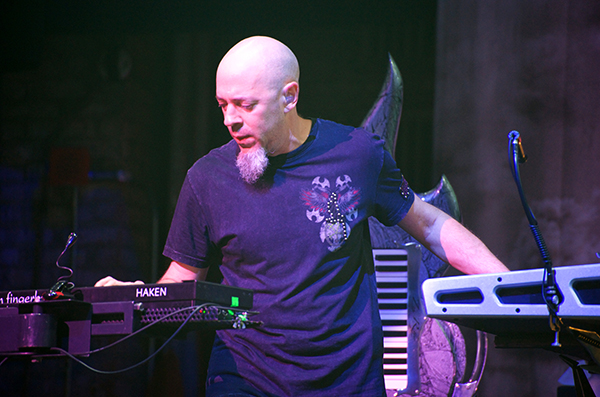
To read our other feature stories on Jordan Rudess, click here.


